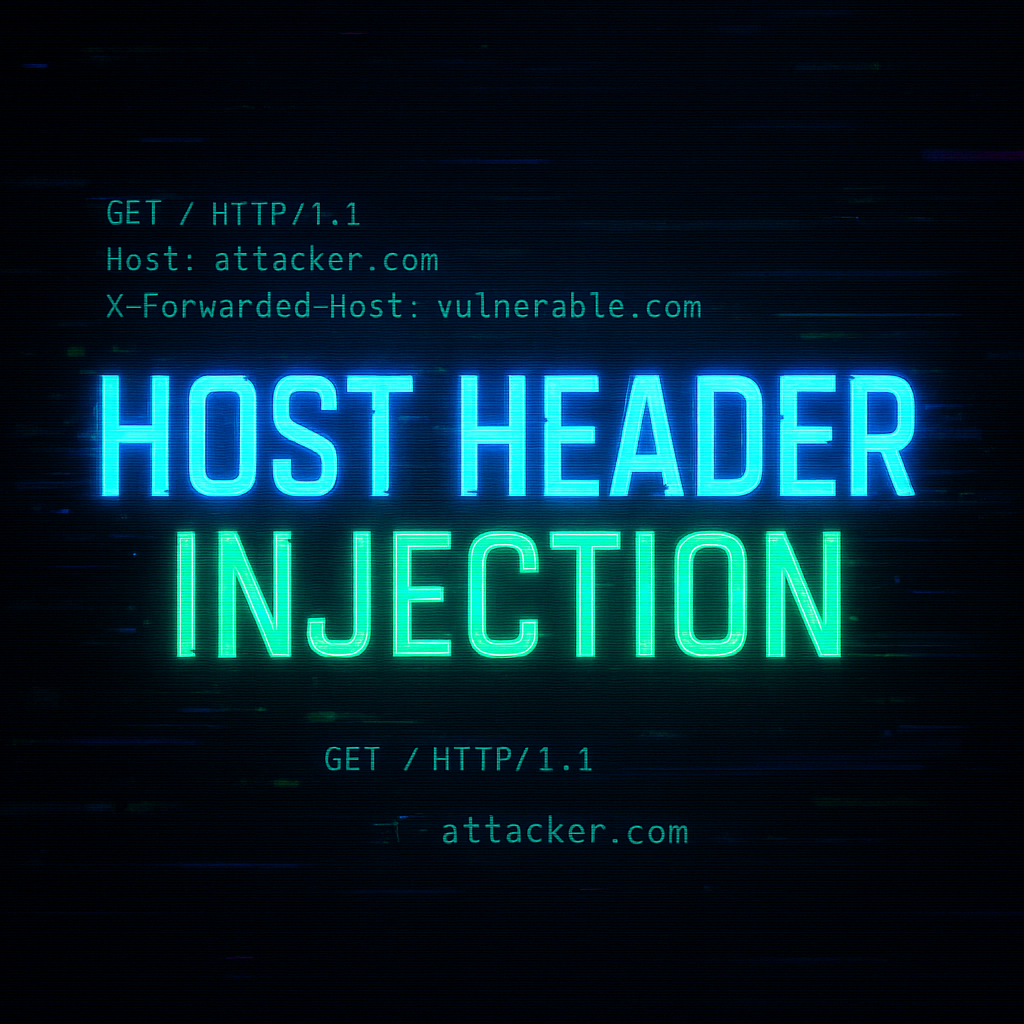Host Header Poisoning: A Hidden Threat in Web Security
Introduction
In the evolving landscape of web application security, many threats go unnoticed or underestimated. One such silent attacker is Host Header Poisoning. Although it doesn’t make headlines like SQL Injection or Cross-Site Scripting (XSS), Host Header Poisoning can lead to serious vulnerabilities in web applications, including cache poisoning, password reset poisoning, virtual host routing issues, and even web cache deception attacks.
At its core, Host Header Poisoning exploits the trust that a server or application places in the HTTP Host header. Web developers often overlook this header, using it for critical logic such as generating absolute URLs, enforcing domain policies, or redirecting users. When an attacker manipulates this header, it can lead to dangerous consequences.
This comprehensive blog explores the concept of Host Header Poisoning, how it works, where it’s commonly found, real-world scenarios, how to test for it, and most importantly—how to prevent it.
Chapter 1: Understanding the HTTP Host Header
The HTTP Host header is a fundamental part of the HTTP/1.1 protocol. It indicates which host the client wants to communicate with. Here’s an example:
GET / HTTP/1.1
Host: www.example.com
Most web servers use the Host header to determine which website to serve when hosting multiple domains (virtual hosting). Without it, the server wouldn’t know how to handle the request properly.
However, the problem arises when web applications read the Host header and trust its value blindly, using it for sensitive logic such as:
- Generating password reset links
- Creating absolute URLs in emails
- Redirecting users to a host
- Allowing access based on the domain
When an attacker sends a malicious Host header, they may be able to trick the application into performing unintended actions.
Chapter 2: Anatomy of a Host Header Attack
Let’s understand a basic Host Header Poisoning attack. Suppose a website sends password reset links via email like this:
Click here to reset your password: https://www.vulnerable.com/reset?token=abc123
The server generates this link dynamically using the Host header:
reset_link = request.host + "/reset?token=" + token
If an attacker sends a request with a custom Host header like:
Host: attacker.com
Then the password reset link becomes:
https://attacker.com/reset?token=abc123
Now, the attacker tricks a user into using that link, sends them to the malicious site, and captures the token—leading to account takeover.
Real-world Consequences:
- Users may be redirected to malicious domains
- Internal systems may trust the wrong host
- Caching systems might store poisoned data
Chapter 3: Common Scenarios Where Host Header Poisoning Occurs
- Password Reset Links
- Applications construct password reset URLs using the Host header. If not sanitized, the link might point to an attacker’s domain.
- Redirection Logic
Location: http://example.comis dynamically generated using the Host header. A poisoned header can redirect users elsewhere.
- Virtual Hosting Systems
- Reverse proxies and load balancers route requests based on the Host. An attacker can access unintended internal services.
- Web Caching Systems
- Poisoned Host headers can trick caching systems like Varnish or Squid into storing malicious content.
- Email Links and Confirmation URLs
- Automated systems that generate emails often use Host headers to build absolute URLs. Malicious headers can hijack links.
Chapter 4: Techniques and Exploitation
Example 1: Password Reset Poisoning
Send the following request:
POST /forgot-password HTTP/1.1
Host: evil.com
If the application uses Host to build the reset link, users will be emailed links to evil.com, controlled by the attacker.
Example 2: Cache Poisoning
Send the following GET request:
GET /index.html HTTP/1.1
Host: evil.com
If the application caches the page, the poisoned version might be served to users accessing the legitimate site.
Advanced Exploitation
- Combine with SSRF (Server-Side Request Forgery)
- Use internal domain spoofing
- Inject headers like
X-Forwarded-Hostfor deeper proxy chains
Chapter 5: Detection and Testing
Manual Testing
Use tools like Burp Suite to intercept and modify the Host header. Watch for:
- Changes in response
- Errors or redirections
- Inclusion of the host in the response body
Automated Tools
- OWASP ZAP
- Nmap scripts (http-host script)
- Custom scripts in Python using
requestsorhttp.client
Key Indicators
- Hostname reflected in response body
- URL in emails points to attacker’s domain
- Misrouted subdomains
- Server errors with mismatched hosts
Chapter 6: Real-World Case Studies
GitHub
In 2013, GitHub was vulnerable to a Host Header Injection that allowed attackers to perform password reset poisoning. They quickly patched it.
Magento
Magento stores were found using the Host header for redirects, leading to phishing-style attacks.
Uber
Uber was reported (via their bug bounty program) to generate confirmation emails using the Host header—potentially exploitable if crafted carefully.
Chapter 7: Mitigation and Prevention
Validate the Host Header
Only allow known and trusted hosts. Reject anything else.
if request.host not in ["example.com", "www.example.com"]:
abort(400)
Use a Configuration Whitelist
Use server-level configs to enforce accepted hosts:
server_name example.com www.example.com;
Avoid Host Header Dependence
- Don’t construct URLs using
Host. Use config files or environment variables instead.
Secure Reverse Proxies
Ensure proxies and load balancers forward valid host headers. Strip or validate X-Forwarded-Host, Forwarded, and similar headers.
Email Validation
When generating email links:
- Use a fixed domain
- Don’t dynamically fetch from headers
Sanitize Headers
Use frameworks and libraries that sanitize headers.
Web Application Firewall (WAF)
Set rules to detect and block suspicious host headers.
Chapter 8: Developer Best Practices
- Always Use Absolute URLs with Caution
- Avoid Dynamically Trusting Headers
- Monitor Logs for Suspicious Host Usage
- Educate Developers on Header Risks
- Perform Regular Security Audits
Chapter 9: Conclusion
Host Header Poisoning is a subtle but impactful security vulnerability. It’s dangerous because it can lie dormant, hidden behind trusted domains, only surfacing when a malicious actor leverages it.
Modern web development often involves proxies, load balancers, microservices, and dynamic routing. This complexity increases the chances of misconfigurations—making it crucial for developers, DevOps engineers, and security professionals to understand and mitigate the risks associated with the Host header.
By being proactive—validating headers, avoiding dynamic URL generation using user input, and configuring servers properly—you can protect your application and your users from this hidden threat.



